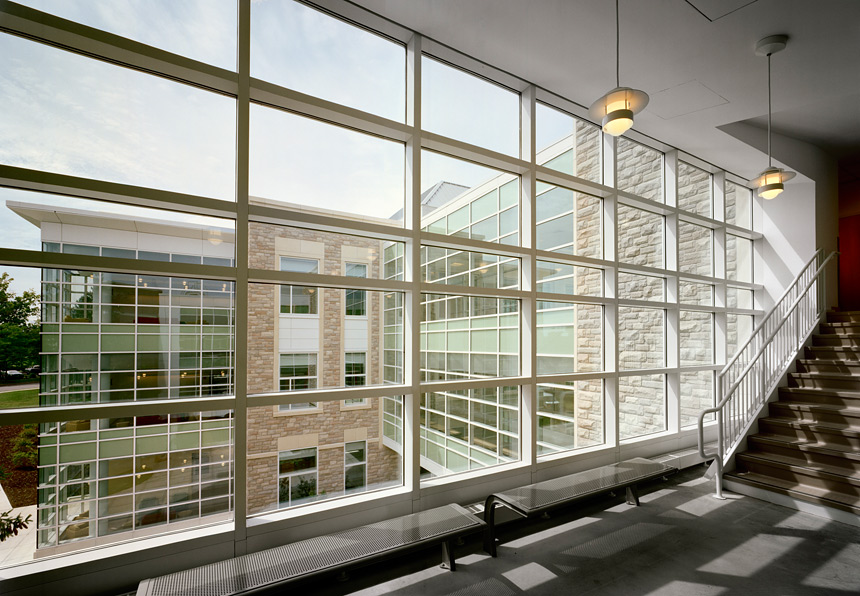Johnson Hall, Built with Sustainability in Mind
St. Lawrence University prides itself on being conscious of climate change and being environmentally friendly. One of the ways that the university has done this is with the construction of Johnson Hall of Science, which is a LEED certified building. However, what does it mean for a building to be LEED certified, and how does Johnson achieve this?
LEED stands for Leadership in Energy and Environmental Design and is one of the most widely used systems for rating green buildings. It was developed by U.S. Green Building Council (USGBC) to provide clear guidelines for building sustainably, both for the environment and people. It works by assigning different sustainable building practice points which a project can earn. This allows different projects to achieve sustainability differently, making sustainable building practices more accessible. Depending on how many points a project earns, they will be given a LEED score of either certified, silver, gold, or platinum. Johnson Hall received a score of 41 out of the 69 available points, earning it a LEED designation of gold.

PHOTO CREDIT: PRESENCE.
One of the categories of points that Johnson earned a lot of points from is the Sustainable Sites category. Sustainable Sites focus on where the building is built, how people get to the building, and how the building interacts with the environment. Johnson earns points for site selection, reducing the development footprint, and alternative transportation, like biking. They also earned points for long-term function of the building in stormwater management, heat island reduction, and light pollution. Both sides of the Sustainable Sites category are important, since they address the initial impact of a building and the ongoing impact of the building on the surrounding environment.
One of the categories of points that Johnson earned a lot of points from is the Sustainable Sites category. Sustainable Sites focus on where the building is built, how people get to the building, and how the building interacts with the environment. Johnson earns points for site selection, reducing the development footprint, and alternative transportation, like biking. They also earned points for long-term function of the building in stormwater management, heat island reduction, and light pollution. Both sides of the Sustainable Sites category are important, since they address the initial impact of a building and the ongoing impact of the building on the surrounding environment.
The amount of consumption, both in energy and resources, of a building, has a large impact on sustainability. For Johnson Hall, measures to limit the consumption of resources have been taken in both the construction and operation of the building.
They sourced over 50 percent of building materials regionally, meaning from within 500 miles of Johnson. They also got points for diverting 75 percent of construction waste from landfills and using recycled materials for 17 percent of the building. In terms of the ongoing operation of the building, there are further reductions in the continual consumption of resources. Johnson also has earned points for a 40 percent decrease in water use and for not using potable water for irrigation.
In terms of energy usage in the building, Johnson Hall earned a few points for the optimization of energy usage. Johnson Hall does not use any renewable energy sources for the energy consumed within the building.
However, it is designed for renewable energy sources to be integrated and used in the future. In terms of energy usage in the building, Johnson Hall earned a few points for the optimization of energy usage. Johnson Hall does not use any renewable energy sources for the energy consumed within the building. However, it is designed for renewable energy sources to be integrated and used in the future.

PHOTO CREDIT: CROXTON COLLABORATIVE ARCHITECTS.
As St. Lawrence continues to move towards being more sustainable and environmentally conscious, there are steps the administration can take. Firstly, the University recently announced a 30-million-dollar facilities enhancement that will primarily be used for dorm renovations. Not only can LEED certification be given to new buildings, but it can also be earned through renovations to an existing building. This is an opportunity for the administration to further the sustainability of St. Lawrence’s campus by renovating dorms like Dean Eaton and Rebert into LEED certified buildings. However, the sustainability of St. Lawrence is also a responsibility of students on campus.
Not only can buildings be LEED certified, but people can also be LEED certified as well. This gives a credential that you have knowledge about how buildings can become LEED certified and sustainable building practices. Since students are the primary users of many spaces on campus, from classrooms to dorms, it’s important that the student body is involved in the planning of buildings on campus. If the student body is educated in sustainable building practices, they will be able to effectively contribute to sustainability on campus.



